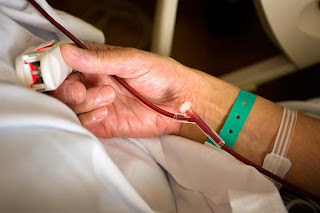The Gift of Life
 On July 12th at 2:30 CST, my wife, Pam, was blessed with one of life's miracles: a bone marrow transplant. It is a miracle on several levels.
On July 12th at 2:30 CST, my wife, Pam, was blessed with one of life's miracles: a bone marrow transplant. It is a miracle on several levels.
The bone marrow came from an anonymous donor. Someone we don't even know or have any idea of where he lives was willing to go through the painful process of a bone marrow donation in order to provide Pam with the distinct possibility of regaining a normal life. Thankfully, there are millions of such individuals around the world that have signed up as potential bone marrow donors. When someone is diagnosed with a blood cancer like leukemia, blood testing is done to find a potential match in the bone marrow registry. This ultimately leads to the patient receiving a donor's marrow. Without it, she would die.
Donor bone marrow is processed to remove everything but blood stem cells. Blood stem cells have the ability to develop into all of the various crucial components of healthy blood: red cells—the carrier of oxygen, white cells—the infection fighters, and platelets—blood's natural coagulation agent. These stem cells are delivered as a simple transfusion and find their way to the patient's bones, where they replace the diseased marrow that has been destroyed by chemotherapy and/or radiation. The photo shows the stem cells making their way to Pam's blood.
These stem cells then set up shop and effectively replace the patient's former immune system. In the process, they kill any residual blood cancer found in the patient. The patient will even take on the blood type of the donor. All of this occurs under a blanket of drug mediated immunosuppression designed to prevent any of the patient's residual immune system from attacking the donor's replacement immune system. Because the patient has no immune system until the new one takes hold, she is temporarily at risk for opportunistic infections. Great care is taken to minimize introduction of infection by isolating the patient during this period.
Once the new immune system matures, the patient recovers and resumes life. There can be residual effects associated with a bone marrow transplant. Pam will always be more susceptible to infection. She will have to avoid overexposure to the sun. But the specter of leukemia will largely be removed. While Pam's journey is still ongoing, a major hurdle has been overcome. In a year, Pam will have the opportunity to communicate with her donor. Until then, we thank you from the bottom of our hearts for your donation.
You can take part in the gift of life by becoming a bone marrow donor. By being in the registry, you join a pool of over 11 million individuals worldwide that stand ready to give someone a future. You can find out more at the website of the National Marrow Donor Program. If you are not located in the U.S., you can find other countries' marrow donor registries here.
Miracles never cease.